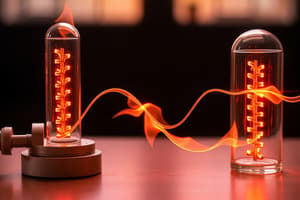Podcast
Questions and Answers
What does the First Law of Thermodynamics state?
What does the First Law of Thermodynamics state?
- The entropy of an isolated system always decreases.
- Energy cannot be created or destroyed, only transformed. (correct)
- Energy can be created or destroyed.
- As temperature approaches absolute zero, entropy increases.
Which of the following processes is characterized by no heat exchange?
Which of the following processes is characterized by no heat exchange?
- Isochoric
- Isobaric
- Adiabatic (correct)
- Isothermal
In a reaction where ΔG < 0, what does this indicate about the process?
In a reaction where ΔG < 0, what does this indicate about the process?
- The process will not occur.
- The process is non-spontaneous.
- The process is spontaneous. (correct)
- The process is at equilibrium.
Which statement about the Zeroth Law of Thermodynamics is true?
Which statement about the Zeroth Law of Thermodynamics is true?
What is the key difference between state functions and path functions?
What is the key difference between state functions and path functions?
In terms of enthalpy (H), what is the correct relationship?
In terms of enthalpy (H), what is the correct relationship?
Which type of process maintains constant volume?
Which type of process maintains constant volume?
What is entropy a measure of in a system?
What is entropy a measure of in a system?
Flashcards are hidden until you start studying
Study Notes
Key Concepts in Chemistry Thermodynamics
-
Thermodynamics: Study of energy, heat, and work in chemical systems.
-
Laws of Thermodynamics:
- Zeroth Law: If two systems are each in thermal equilibrium with a third system, they are in thermal equilibrium with each other.
- First Law: Energy cannot be created or destroyed, only transformed (ΔU = Q - W, where ΔU is the change in internal energy, Q is heat added to the system, and W is work done by the system).
- Second Law: Entropy of an isolated system always increases; natural processes favor the direction of increasing disorder.
- Third Law: As the temperature approaches absolute zero, the entropy of a perfect crystal approaches zero.
-
Key Terms:
- System: The part of the universe being studied (open, closed, isolated).
- Surroundings: Everything outside the system.
- State Functions: Properties that depend only on the state of the system (e.g., internal energy, enthalpy, entropy).
- Path Functions: Properties that depend on the path taken (e.g., heat, work).
-
Types of Processes:
- Isothermal: Constant temperature (ΔU = 0).
- Adiabatic: No heat exchange (Q = 0).
- Isochoric: Constant volume (W = 0).
- Isobaric: Constant pressure.
-
Enthalpy (H): Measure of total heat content; H = U + PV (where P is pressure and V is volume).
-
Entropy (S): Measure of disorder or randomness in a system.
-
Gibbs Free Energy (G): Indicates the spontaneity of a process; G = H - TS (where T is temperature in Kelvin).
- If ΔG < 0, the process is spontaneous.
- If ΔG > 0, the process is non-spontaneous.
-
Heat Capacity (C): Amount of heat required to change the temperature of a substance by one degree.
- Specific heat capacity (c): Heat capacity per unit mass (C = mc).
-
Calorimetry: Measurement of heat changes in chemical reactions; uses calorimeters to measure heat (Q = mcΔT).
Applications:
- Understanding reaction spontaneity, equilibrium, and chemical reaction rates.
- Designing energy-efficient processes in chemical engineering.
- Predicting physical changes and properties of materials.
Thermodynamics
- Study of energy and its transformations in chemical systems.
- Four Fundamental Laws: Define the behavior of energy in the universe.
- Zeroth Law: Systems in thermal equilibrium with the same third system are also in equilibrium with each other.
- First Law: Energy cannot be created or destroyed, only transformed.
- Expressed through the equation:
ΔU = Q - WΔUrepresents the change in internal energy.Qrepresents heat added to the system.Wrepresents work done by the system.
- Expressed through the equation:
- Second Law: Entropy of an isolated system always increases over time.
- Natural processes tend toward greater disorder.
- Third Law: As the temperature of a crystalline substance approaches absolute zero, its entropy approaches zero.
Key Terms
- System: The specific part of the universe under observation. Can be:
- Open System: Can exchange both energy and matter with its surroundings.
- Closed System: Exchanges energy but not matter.
- Isolated System: Does not exchange energy or matter.
- Surroundings: Everything outside the system.
- State Functions: Properties that depend only on the current state of the system, not the path taken to reach that state.
- Examples: Internal energy (U), enthalpy (H), entropy (S).
- Path Functions: Properties that depend on the specific path taken to reach a state.
- Examples: Heat (Q) and work (W).
Types of Processes
- Isothermal: Constant temperature (
ΔU = 0). - Adiabatic: No heat exchange (
Q = 0). - Isochoric: Constant volume (
W = 0). - Isobaric: Constant pressure.
Enthalpy
- Measure of total heat content of a system.
H = U + PVPis pressure.Vis volume.
Entropy
- Measure of disorder or randomness in a system.
- A high entropy state is very disordered.
Gibbs Free Energy
- Indicates the spontaneity of a process.
G = H - TSTis temperature in Kelvin.
- Spontaneous processes:
ΔG < 0. - Non-spontaneous processes:
ΔG > 0.
Heat Capacity
- Amount of heat required to change the temperature of a substance by one degree.
C = mc(wherecis specific heat capacity andmis mass).
Calorimetry
- Measuring heat changes in chemical reactions.
- Uses calorimeters to measure heat.
Q = mcΔT
Applications of Thermodynamics
- Understanding the spontaneity of chemical reactions and the factors that affect them.
- Predicting chemical equilibrium and reaction rates.
- Optimizing energy efficiency in industrial chemical processes.
- Determining the physical changes and chemical properties of materials.
Studying That Suits You
Use AI to generate personalized quizzes and flashcards to suit your learning preferences.




